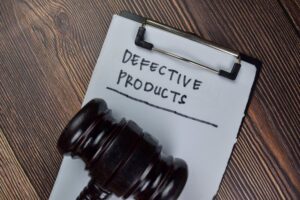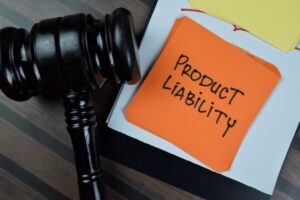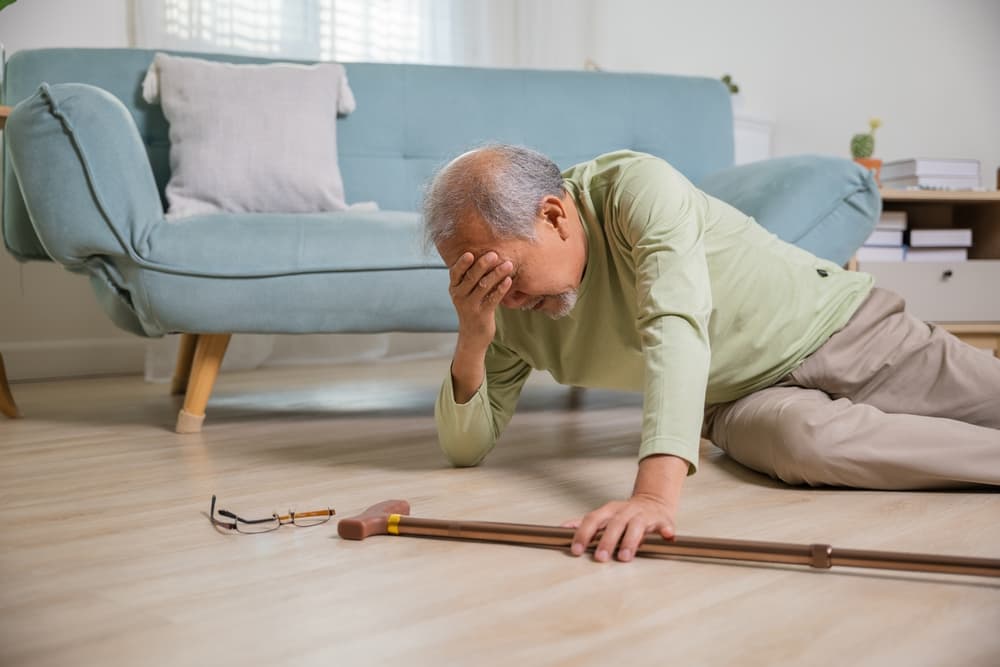If a product is in stores, online, or placed in the marketplace in another way, it should not be defective. If a company sells a defective product and a customer gets hurt, they may have a legal claim against the manufacturer.
Product liability is the area of law that holds manufacturers accountable for selling defective or dangerous products. Product liability can be complex, as proving a product was defective and caused injuries is challenging. Continue reading to learn more about the most common defective products, and contact a product liability attorney to discuss a possible case.
What Is a Defective Product?

Defective products are products for sale that don’t perform as they should. A defect is anything that makes the product unsafe, and unsafe products put customers in danger of unexpected injuries. A product may have a defective design, a manufacturing defect, or the manufacturer failed to warn about the risks associated with using the product.
A customer can prove the product is defective if they use the product as intended but suffer an unpredictable injury.
What Is a Recall?
A recall is an action of taking defective or unsafe products off the marketplace. Whenever a product poses a danger to the health or safety of consumers, it should have recalled. If a manufacturer fails to safely assemble a product, there is a design defect, or the manufacturer fails to put a warning on the product about dangerous aspects of the product that can harm them, the company might issue a recall.
Failure to Warn
Manufacturers must place adequate warning labels on products or give customers sufficient warning about any potential risk of injury caused by their product. A manufacturer is only required to warn consumers if the item is dangerous when used as intended, the manufacturer knows about the danger, and the threat is not evident.
A passing mention of the dangers of the product is not enough. If a product is inherently risky or dangerous, the manufacturer’s warning must be prominently displayed, direct, and detailed. The warning must clearly explain any potential risk of harm to the customer.
Defective Manufacture
A company might have assembled a defective product incorrectly and, therefore, it did not work as intended. Human error and poor-quality materials are the two major causes of defective manufacturing. If the manufacturer releases defective products for sale, they can face civil penalties. A manufacturing defect is accidental and may affect a small percentage of consumers.
If you suspect a manufacturing defect caused your injury, contact an experienced products liability attorney to assist you. Although a manufacturing defect may not be obvious, a plaintiff can recover damages if they can prove the product caused their injury.
Manufacturers will work to defend themselves from defective manufacturing lawsuits. Common defenses to product liability claims based on defective manufacturing include the assumption of the risk and that someone altered the product after it left the manufacturer. Assumption of risk means the customer knew the product was dangerous and used it anyway. Manufacturers that use the alteration argument usually claim the store where the customer purchased the product damaged it or the customer used the product in an unintended way.
Defective Design
A design defect may exist if a properly manufactured product causes injury to the customer when they use it as intended. The defect is a part of the design of the product itself.
A person who claims that a poorly designed product injured them must prove:
- That a different hypothetical design is safer for consumers than the current design
- That the hypothetical design is as workable as the current design
- The hypothetical design does not place an unreasonable economic burden on the manufacturer
- The primary purpose of the alternate design is the same as the original design
Medical Devices
The center of many product liability cases is defective medical devices. Most Americans will need medical care at some point in their lives. Patients rely on doctors, nurses, medical staff, and hospitals to use working medical devices when delivering care.
A medical device is an instrument used in surgery or medical care. Examples of medical devices include pacemakers, prosthetics, surgical equipment, implants, etc. Examples of some defective medical devices you may have heard of on the news or online include:
Metal Hip Replacements
In the early 2000s, hip replacements using metal implants became very popular. As time passed, more patients reported suffering complications from the implants. Metal implants were largely recalled, but not before doctors discovered that patients suffered metal poisoning and implant failures.
Transvaginal Mesh
Transvaginal mesh is a medical device used to treat stress urinary incontinence and pelvic prolapse in women. Transvaginal mesh is a net-like material placed inside a woman’s body to treat her condition. Many women reported they suffered from organ perforation and mesh erosion. Women who have suffered injury sued for damages.
Da Vinci Surgical Robots
Decades ago, surgeons across the country began using Da Vinci surgical robots to complete complex surgeries. Da Vinci surgical robots assist with surgeries that require doctors to reach areas that are difficult to reach manually. While this was a major medical advancement, many patients suffered from complications. Patients sued for damages after suffering from electrical burns, pierced organs, and infections because of the medical device.
Guidant Defibrillators
Guidant implantable defibrillators and cardiac resynchronization therapy defibrillators are widely used in the United States to treat heart disease. The Food and Drug Administration issued a nationwide recall of Guidant defibrillators in past years. The FDA recalled these medical devices after serious injuries and deaths stemmed from their use.
The Food and Drug Administration sets the standards that manufacturers of medical devices must meet to ensure that only safe medical devices go into the hands of doctors and hospitals.
Pharmaceutical Drugs
Patients should be able to rely on medication to help heal and treat their illnesses and chronic conditions. Despite the hope many patients place in pharmaceutical drugs, many people report injuries caused by various medications every year.
Pharmaceutical drugs can be defective due to marketing, manufacturing, or failure to warn. The company that manufactured the drug may mislabel the medication, fail to include the dosage, etc. A pharmaceutical company may also make a marketing mistake if it fails to inform doctors and consumers of a side effect they should be aware of. Both market and manufacturing failures can lead to severe injuries or death.
Potential defects in pharmaceutical drugs may include:
- Incorrect dosage or concentration printed on the medication packaging
- Exposure to contamination or bacterial growth
- Incorrect packaging
- Recalled drugs placed onto the marketplace
Children’s Toys
Children’s toys are among the most recalled household items across the country. Defects in toys result from manufacturing or design defects or the manufacturer’s failure to warn the consumer about the potential dangers of the faulty toy.
Typical defects in toys include:
- Small, removable pieces that create a choking hazard for young children
- Toys with sharp edges can cause serious lacerations
- Toys painted with contaminated paint can lead to serious illnesses, like lead poisoning
Injuries caused by defective toys can include:
- Cuts, bruises, and fractures
- Suffocation
- Poisoning
- Toxic chemical exposure
Household Appliances
Defective household appliances can place consumers in danger. If a household appliance has a warning, design, or manufacturing defect, consumers may have exposure to severe hazards, including choking, electrocution, fire, drowning, lacerations, and more.
Common defective household appliances that, if defective, can contribute to consumer injuries include, but are not limited to:
- Space heaters
- Cords and plugs
- Fans
- Lamps and other lighting fixtures
- Washers and dryers
- Dishwashers
- Transformers
- Electric blankets
- Heating pads
- Microwaves
Household Chemicals and Cleaning Products
Completing simple chores like washing dishes and bed sheets can expose you to harmful household chemicals. You might be entitled to compensation if you suffered an injury due to chemical exposure to a defective household cleaning product.
Defective household chemicals pose a unique risk to consumers because these products may not cause immediate injury. Long-term exposure to defective household chemicals and cleaning products can create chronic health issues that the consumer may not notice for several months, even years.
Examples of potentially defective household chemicals and cleaning products include:
- Latex paint and paint removers
- Antifreeze
- Household pesticides
- Bleach, dish soap, and laundry detergent
- Floor and bathroom cleaners
Industrial Equipment and Machinery
Accidents due to defective industrial equipment or machinery are among the deadliest types of accidents. If you are involved in an accident caused by a manufacturing defect, you may have a product liability claim against the manufacturer. A family member of an accident victim who died in an accident may have a wrongful death claim.
Common types of industrial equipment include bulldozers, backhoes, bulldozers, circular saws, forklifts, graders, etc. Any part of these machines can have a defect that might lead to a devastating or deadly injury.
Defects that can exist in industrial machinery include:
- Manufacturer’s failure to warn of safety concerns that are not obvious
- Machines that frequently overheat
- Low-quality materials
- Lack of industry-standard safety devices (i.e., automatic off-switch)
- Faulty wiring
Even if your injuries are obvious, proving your case might be difficult. An experienced products liability attorney can help you work to get the compensation you deserve.
Motor Vehicles
Any malfunctioning part or component of a motor vehicle that places the driver or their passengers in danger of injury is a motor vehicle defect. In most cases, motor vehicle defects result from a manufacturer’s error. In the United States, manufacturers creating motor vehicle parts and components must meet federal safety standards.
Operators of cars, motorcycles, buses, vans, and trucks might have a legal claim against the motor vehicle manufacturer if they suffered an injury in an accident caused by a motor vehicle defect.
Examples of common motor vehicle defects include:
- Electrical or computer malfunctions
- Defective steering wheels
- Jamming brakes or gas pedal
- Faulty tires
Food
When you hear about defective food products, you may think of food that causes you to get sick with food poisoning. Food poisoning is one consequence of a defective food product. Symptoms of food poisoning can include sweating, chills, loss of appetite, nausea, vomiting, exhaustion, abdominal cramps, and diarrhea.
Consuming defective food products can leave a person in bed for days, with massive hospital bills and losing time at work. If your defective food products claim is successful, you may be entitled to recover your damages.
The Food and Drug Administration (FDA) has the power to regulate what food goes onto the shelves of American grocery stores. The Food Safety Enhancement Act of 2009 imposed stricter guidelines for food retailers to ensure that they only sell food free from contamination to not place consumers at risk of illness.
Other examples of food product defectives include:
- Chemical contamination
- Failure to place a warning label on a product that contains an allergen
- Poor sanitation
Cosmetics
Everyone uses cosmetic products. A defective cosmetic product can leave you with serious injuries, whether the product is perfume, cologne, make-up, hair, lotion, shaving cream, or deodorant. Since cosmetics contain chemicals, defective cosmetic products place consumers at risk of injury from chemical contamination. The Food, Drug, and Cosmetic Act describes the safety regulations cosmetic producers must follow to ensure that defective cosmetic products do not make it to the market.
Why Do I Need a Product Liability Attorney?

An attorney can help protect your legal rights after an injury caused by a defective product. Product liability cases can be hard to prove, but you deserve compensation for injuries you suffered due to a defective product. Because of the complex nature of product liability claims, accident victims need an experienced and knowledgeable attorney on their side to protect their legal interests and increase their odds of successfully getting compensation for their injuries.
An experienced attorney can protect your legal interests by speaking to insurance companies and third parties on your behalf. Your lawyer can conduct a thorough investigation to determine the cause of the accident and interpret the law surrounding the requirements for product safety and liability.



